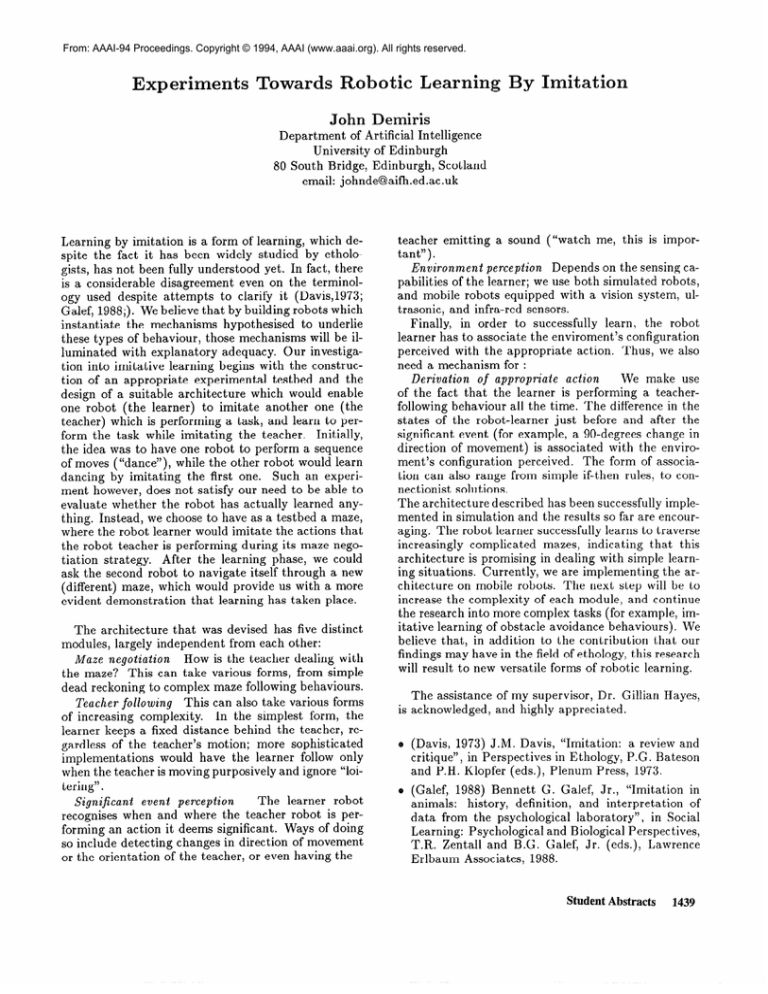
From: AAAI-94 Proceedings. Copyright © 1994, AAAI (www.aaai.org). All rights reserved.
Experiments
Towards
Robotic
Learning
By Imitation
John Demiris
Department
of Artificial Intelligence
University of Edinburgh
80 South Bridge, Edinburgh,
Scotland
email: johnde@aifh.ed.ac.uk
Learning by imitation is a form of learning, which despite the fact it has been widely studied by ethologists, has not been fully understood yet. In fact, there
is a considerable
disagreement
even on the terminology used despite attempts
to clarify it (Davis,1973;
Galef, 1988;). We believe that by building robots which
instantiate
the mechanisms
hypothesised
to underlie
these types of behaviour, those mechanisms will be illuminated with explanatory
adequacy.
Our investigation into imitative learning begins with the construction of an appropriate
experimental
testbed and the
design of a suitable architecture
which would enable
one robot (the learner) to imitate another one (the
teacher) which is performing a task, and learn to perform the task while imitating
the teacher.
Initially,
the idea was to have one robot to perform a sequence
of moves (“dance”),
while the other robot would learn
dancing by imitating
the first one. Such an experiment however, does not satisfy our need to be able to
evaluate whether the robot has actually learned anything. Instead, we choose to have as a testbed a maze,
where the robot learner would imitate the actions that
the robot teacher is performing during its maze negotiation strategy.
After the learning phase, we could
ask the second robot to navigate itself through a new
(different) maze, which would provide us with a more
evident demonstration
that learning has taken place.
The architecture
that was devised has five distinct
modules, largely independent from each other:
Maze negotiation
How is the teacher dealing with
the maze? This can take various forms, from simple
dead reckoning to complex maze following behaviours.
Teacher following
This can also take various forms
In the simplest form, the
of increasing
complexity.
learner keeps a fixed distance behind the teacher, regardless of the teacher’s motion; more sophisticated
implementations
would have the learner follow only
when the teacher is moving purposively and ignore “loitering”.
The learner robot
Significant
event perception
recognises when and where the teacher robot is performing an action it deems significant.
Ways of doing
so include detecting changes in direction of movement
or the orientation
of the teacher, or even having the
teacher emitting a sound (“watch me, this is important”).
Environment
perception
Depends on the sensing capabilities of the learner; we use both simulated robots,
and mobile robots equipped with a vision system, ultrasonic, and infra-red sensors.
Finally,
in order to successfully
learn, the robot
learner has to associate the enviroment’s
configuration
perceived with the appropriate
action. Thus, we also
need a mechanism for :
Derivation
of appropriate
action
We make use
of the fact that the learner is performing
a teacherfollowing behaviour all the time. The difference in the
states of the robot-learner
just before and after the
significant event (for example, a go-degrees change in
direction of movement) is associated with the enviroment’s configuration
perceived.
The form of association can also range from simple if-then rules, to connectionist solutions.
The architecture
described has been successfully implemented in simulation and the results so far are encouraging. The robot learner successfully learns to traverse
increasingly
complicated
mazes, indicating
that this
architecture
is promising in dealing with simple learning situations.
Currently, we are implementing
the architecture on mobile robots. The next step will be to
increase the complexity
of each module, and continue
the research into more complex tasks (for example, imitative learning of obstacle avoidance behaviours).
We
believe that, in addition to the contribution
that our
findings may have in the field of ethology, this research
will result to new versatile forms of robotic learning.
The assistance
acknowledged,
of my supervisor, Dr. Gillian
and highly appreciated.
Hayes,
(Davis, 1973) J.M. Davis, “Imitation:
a review and
critique”, in Perspectives
in Ethology, P.G. Bateson
and P.H. Klopfer (eds.), Plenum Press, 1973.
(Galef, 1988) B ennett G. Galef, Jr., “Imitation
in
animals:
history, definition,
and interpretation
of
data from the psychological
laboratory”,
in Social
Learning: Psychological
and Biological Perspectives,
T.R. Zentall and B.G. Galef, Jr. (eds.), Lawrence
Erlbaum Associates,
1988.
Student Abstracts
1439



